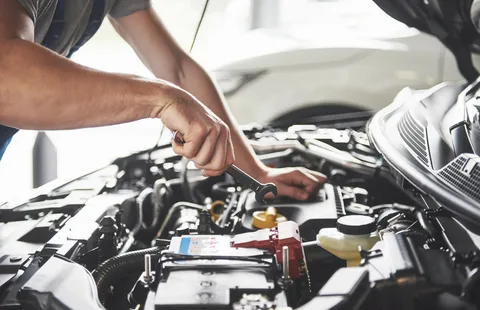Is your car ready for the road ahead?
Discover the secrets to keeping your vehicle running smoothly and efficiently in this blog.
From maximizing performance to ensuring safety, we've got you covered with expert advice that will have your car purring like a contented engine.
Whether you're a seasoned car enthusiast or a new driver, these essential maintenance tips, along with the implementation of cutting-edge "Tire Point of Sale Software," will help you avoid breakdowns and costly repairs, giving you peace of mind on every journey.
In this comprehensive guide, we'll delve into the crucial aspects of car maintenance, uncovering the secrets that every car owner should know.
Regular Oil Changes
Importance of Clean Oil for Engine Performance:
Clean oil ensures that these components work smoothly, efficiently, and with minimal heat generation. It also helps in carrying away debris and contaminants, keeping the engine clean and protected. Failure to change the oil at appropriate intervals can lead to the accumulation of harmful sludge and reduce engine efficiency, potentially causing long-term damage.
How to Check Oil Levels and Identify Signs of Dirty Oil:
Regularly check your car's oil level using the dipstick. Park the car on level ground, let the engine cool down, and pull out the dipstick to inspect the oil level. Additionally, clean oil should appear amber or light brown on the dipstick. If the oil is dark, gritty, or has a burnt smell, it's time for an oil change.
Tire Maintenance:
How to Check Tire Pressure and When to Do It:
Regularly check your tire pressure using a tire pressure gauge when the tires are cold (before driving the car). Refer to the vehicle owner's manual or a sticker located on the driver's door jamb or the inside of the fuel filler flap for the recommended tire pressure. It's a good practice to check the tire pressure at least once a month and before long road trips.
Tire Rotation and Its Benefits for Even Tire Wear:
Tire rotation is the process of moving tires from one position to another on the vehicle to achieve more even tread wear. Since front and rear tires wear differently, rotating them helps extend the overall lifespan of the tires and ensures a more balanced and stable ride. Regular tire rotation also maintains better traction and improves the vehicle's handling.
How to Identify Signs of Tire Wear and When to Replace Tires:
Regularly inspect your tires for signs of wear, such as uneven tread wear, bulges, cracks, or a tread depth approaching 2/32 of an inch (the minimum legal requirement in many regions). An easy way to check tread depth is by using a penny – insert it into the tire's tread with Lincoln's head facing downwards; if you can see the top of Lincoln's head, it's time to replace the tires. Additionally, if you notice any unusual vibrations or handling issues, it's essential to have your tires inspected by a professional mechanic. Replacing tires before they become too worn is essential for maintaining traction, safety, and overall vehicle performance.
Brakes Inspection:
Signs of Worn-out Brake Pads or Brake Fluid Issues:
Worn-out brake pads can exhibit warning signs such as squealing or grinding noises when applying the brakes. A soft or spongy brake pedal could indicate air or moisture in the brake fluid, affecting the braking efficiency. Additionally, a dashboard warning light related to the braking system should not be ignored. If any of these signs are present, it's crucial to address them promptly to avoid potential brake failure.
Steps to Inspect Brake Components and When to Seek Professional Help:
To inspect the brakes, visually check the brake pads through the wheel spokes. If the pads appear too thin, they need replacement. Examine the brake lines for any signs of leaks or damage. If you notice any concerning issues during inspection or experience unusual braking behavior, it's essential to seek professional help from a qualified mechanic. They can conduct a thorough brake inspection, identify the root cause of the problem, and perform any necessary repairs or replacements.
Tips for Extending the Life of Your Brakes:
To prolong the life of your brakes, practice smooth driving habits and avoid abrupt stops. Try to anticipate traffic flow to minimize the need for sudden braking. Regularly inspect and replace brake pads as recommended by the vehicle's manufacturer. Properly maintain the brake fluid level and adhere to the recommended brake fluid replacement intervals.
Fluid Checks and Top-ups:
How to Check Fluid Levels and Identify Leaks:
To check fluid levels, consult the vehicle's owner's manual for the specific locations of dipsticks and reservoirs. For engine oil and transmission fluid, use the dipsticks to check levels, ensuring they are within the recommended range. For other fluids like coolant, brake fluid, and power steering fluid, check the levels in their respective reservoirs. Inspect for any signs of leaks, such as puddles or stains under the car, and address them promptly to prevent fluid loss and potential damage to the vehicle.
Importance of Timely Fluid Replacements and Top-ups:
Regular fluid replacements and top-ups are essential for maintaining the proper functioning of the vehicle's systems. Over time, fluids can degrade, accumulate contaminants, or lose their effectiveness. Timely replacements ensure optimal performance and prevent costly repairs. Top-ups are equally important, especially for fluids like engine oil or coolant that gradually deplete with usage. Ignoring low fluid levels can lead to engine overheating, transmission issues, brake failure, and other problems.
Warning Signs of Fluid-Related Issues:
Fluid-related issues often manifest through warning signs. For instance, an engine temperature gauge in the red zone could indicate coolant problems, while a slipping transmission or difficulty shifting gears may be a sign of low transmission fluid. Spongy brakes or a brake warning light may suggest low brake fluid levels.
Battery Maintenance:
Understanding the Car Battery and Its Function:
The car battery is a vital component that provides electrical energy to start the engine and power various electrical systems in the vehicle. When you turn the key, the battery delivers a surge of electricity to the starter motor, initiating the combustion process. It also supplies power to lights, radio, air conditioning, and other electrical accessories when the engine is not running. Understanding the battery's role and keeping it in good condition is essential for reliable vehicle performance.
How to Inspect Battery Connections and Clean Corrosion:
Regularly inspecting the battery connections is crucial for maintaining a strong electrical connection. Start by turning off the engine and ensuring the vehicle is in park with the parking brake engaged. Remove the battery terminal clamps and clean any corrosion using a mixture of baking soda and water or a dedicated battery terminal cleaner. Rinse with water and dry thoroughly before reattaching the terminals, ensuring they are securely tightened.
Tips to Prolong the Life of Your Car Battery:
To extend the life of your car battery, avoid leaving lights or accessories on when the engine is off. Limit short trips as they may not allow the battery to fully recharge. Ensure the battery is securely fastened to minimize vibration. During long periods of inactivity, consider using a battery tender or trickle charger to maintain optimal charge levels. Extreme temperatures can also affect battery performance, so parking in shaded areas during hot weather or using block heaters in cold weather can be beneficial.
Conclusion
Embrace this technology and stay ahead in the competitive automotive industry.
Also, consider exploring "Body Shop Estimating Software" to optimize estimating and repair processes for your body shop. Leverage technology for success in today's fast-paced automotive landscape.








